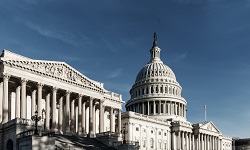 How Leading Research Universities Are Helping Combat Climate Change
How Leading Research Universities Are Helping Combat Climate Change
Last Friday, AAU President Barbara R. Snyder moderated a roundtable discussion on “The Role of Leading Research Universities in Advancing Climate Solutions” at the Right Here, Right Now Global Climate Summit at the University of Colorado Boulder. The three-day summit focused on addressing the effects of climate change on human rights and was co-hosted by United Nations Human Rights and CU Boulder.
The roundtable featured University of Arizona President Robert C. Robbins, University of Minnesota President Joan T.A. Gabel, The Ohio State University President Kristina M. Johnson, and CU Boulder Chancellor Philip P. DiStefano as panelists. The hour-long, wide-ranging discussion focused on how America’s leading research universities are fighting climate change by reducing their own carbon footprint and through research and innovation that is helping communities and nations around the world find climate solutions.
President Robbins spoke about how, as a land-grant university and a university located in a state that is already seeing the effects of severe heat and drought, the University of Arizona has a keen interest in climate issues. He emphasized that climate solutions must be centered on human rights and be respectful of indigenous societies and culture. As an example, he spoke about Arizona’s Indigenous Resilience Center, through which researchers are working collaboratively with the Navajo Nation to address lack of running water and electricity in their communities.
Chancellor DiStefano also highlighted the importance of interdisciplinary research and scholarship in helping find solutions. He discussed how CU Boulder faculty are building community resilience in the face of increasingly severe natural disasters such as wildfires and hurricanes. Similarly, President Johnson talked about Ohio State’s Sustainability Institute, which collaborates with academic units across the university to advance sustainability on campus as well as sustainability research.
All panelists discussed what their universities are doing to reduce their own institutions’ carbon footprints, including moving to solar and wind energy, reducing water consumption, and crafting climate action plans. President Johnson, for example, talked about Ohio State’s aggressive plan to achieve net-zero emissions and how partnering with the private sector, especially local energy companies, can be helpful in this regard. President Gabel talked at length about how the University of Minnesota is implementing four of the United Nations’ Sustainable Development Goals to help the campus become more sustainable and to promote research, teaching, and partnerships that would help create a greener future. She discussed how the goals are allowing the university to create benchmarks to measure progress and to engage and inspire faculty, students, staff, and the local community.
As President Robbins said during the discussion, climate change is not a crisis of the future; it’s happening now and happening rapidly, and higher education institutions are uniquely positioned to do something about it.
 Hill Update: Democrats Plan Omnibus Spending Package, One-Year CR; House Passes FY23 NDAA
Hill Update: Democrats Plan Omnibus Spending Package, One-Year CR; House Passes FY23 NDAA
Yesterday, House Appropriations Committee Chair Rosa DeLauro (D-CN) announced that Democrats will release an omnibus government funding package on Monday even as Democrats and Republicans continue negotiations over how much money to spend on non-defense activities in FY23. (Democrats want about $25 billion more than Republicans.) Senate Appropriations Committee Vice Chair Richard Shelby (R-AL) told reporters, however, that the package will be dead on arrival since negotiations are continuing. Rep. DeLauro warned that if lawmakers are unable to reach an agreement, Congress may have to resort to a year-long continuing resolution to keep the government funded for the rest of the fiscal year.
In other news, the House voted 350-80 yesterday to pass the FY23 National Defense Authorization Act (H.R. 7776). The bill provides nearly $858 billion in defense spending, $45 billion more than President Biden requested. It includes $817 billion for the Department of Defense and $30 billion for the Department of Energy. The Senate is expected to take up the bill next week.
 United for Medical Research Urges Robust Funding for NIH
United for Medical Research Urges Robust Funding for NIH
United for Medical Research, of which AAU is a founding member, sent a letter yesterday urging the House and Senate leadership to pass a FY23 omnibus spending bill that increases the budget of the National Institutes of Health by at least $2.5 billion. The NIH is the federal government’s medical research agency; biomedical and health research funded by the NIH has led to countless discoveries and innovations that have improved the health of all Americans.
As the letter noted, the agency has seen sustained increases to its funding over the last few years that have allowed it to perform critical lifesaving research. For example, NIH-driven research led to the development of COVID-19 vaccinations, and researchers are now using mRNA technology to develop a universal flu vaccine. As the letter emphasized, however, without a FY23 funding bill “NIH would be forced to delay research” – an outcome that would cost lives and harm public health. Increasing NIH’s funding by at least $2.5 billion in FY23, the letter concluded, “will ensure the United States continues making biomedical research innovation a national priority.”
Former NSF Directors and NSB Chairs Send Letters Urging CHIPS-Level Funding for NSF
A group of former directors of the National Science Foundation and former chairs of the National Science Board recently sent letters to President Biden and Vice President Harris and to leaders of the House and Senate Appropriations Subcommittees on Commerce, Justice, and Science urging them to fund the NSF in FY23 and FY24 at the levels authorized in the CHIPS and Science Act, which was passed and signed into law earlier this year.
Both letters emphasized that the enhanced levels of funding are needed to keep the United States globally competitive and to fuel economic growth and prosperity. “Without a significant and sustained increased investment in our fundamental research enterprise, it is only a matter of time before our competitors overtake the United States in certain aspects of technological primacy,” the letters noted.
 AAU Joins Coalition Opposing Pride in Patent Ownership Act
AAU Joins Coalition Opposing Pride in Patent Ownership Act
Earlier this week, AAU joined the Innovation Alliance and five other organizations in sending a letter to the leaders of the Senate Judiciary Committee opposing the Pride in Patent Ownership Act (S. 2774). The bill requires patent-holders to publicly disclose certain patent-related information to the U.S. Patent and Trademark Office, including information about the patent’s owners and funders. The bill also reduces the amount of damages patent-holders can recover in case they fail to record changes to their patents within 120 days and become victims of patent infringement.
The coalition’s letter noted that the legislation “is a solution in search of a problem that actually rewards willful infringement for intellectual property theft.” The letter argued that the bill would harm innovation by “unfairly and excessively” punishing inventors and patent-holders, especially start-ups and universities, for record-keeping errors. Further, in requiring a registry of all patent transactions, the bill would provide “a ledger of potential targets for infringers seeking to track developing technologies,” the letter noted. “Invention is the engine of economic growth and job creation in the United States, and we cannot afford to stymie our innovation ecosystem,” the letter emphasized.
News of Interest
New Hampshire Union Leader: Dartmouth Invests $100 Million in STEM Diversity Program – Dartmouth College is investing $100 million in a new program to boost diversity in STEM fields. The STEM-X program will help support underrepresented students by investing millions of dollars in undergraduate research opportunities, need-based scholarships, and faculty development and recruitment.
The New York Times: ‘Innovation Hubs’ Aim to Lift Distressed Areas. Congress Just Has to Fund Them. – The CHIPS and Science Act authorized $10 billion for a series of “innovation hubs” to spur economic growth in struggling regions across the country and to help turn scientific research into “new and marketable industrial applications.” But Congress has yet to provide the funds to get the innovation hubs off the ground.
Inside Higher Ed: Faculty Diversification Must Accelerate, Report Says – A new study finds that colleges and universities need to make more concerted efforts to ensure that the professoriate reflects the diversity of the American population. The study says that collectively increasing the number of underrepresented faculty by just 1 percentage point per year would help colleges and universities reach true faculty diversity by 2050.
The Washington Post: Congress Working to Strike Last-Minute Immigration Deals – Sens. Kyrsten Sinema (I-AZ) and Thom Tillis (R-NC) revealed that they’re working on a new immigration proposal to provide a path to citizenship for recipients of the Deferred Action for Childhood Arrivals program and to enhance border security. The proposal, however, faces long odds before Congress.
Inside Higher Ed: NYU Puts $1 Billion into Brooklyn Engineering School – New York University announced that it is investing $1 billion in its Tandon School of Engineering. The funds will be used to renovate labs and student spaces, hire tenure-track faculty, and expand the school’s cybersecurity and artificial intelligence programs.
Featured Research

Do Electric Scooters Reduce Car Use?
Research conducted by the Georgia Institute of Technology Data Science and Policy Lab shows that investing in e-scooters, e-bikes, and bike lanes can reduce traffic congestion and carbon emissions in cities. Researchers studied Atlanta’s ban on e-scooters and e-bikes in 2019 and found that the ban led to traffic congestion and a 10% increase in average commute times.

Brain-Powered Wheelchair Shows Real-World Promise
Engineers at the University of Texas at Austin have successfully completed a study in which people with motor disabilities were able to use their minds to operate a wheelchair in a natural environment. The “thought powered wheelchair” sends users’ brain electrical activity to a computer, which then translates their intentions into movement.
Upcoming Events
 The White House Office of Science and Technology Policy is hosting a virtual summit on STEMM Equity and Excellence on Monday, December 12, at 10:00 a.m. ET. According to the White House, the summit will bring together people across science, technology, engineering, mathematics, and medicine who are “committed to working collaboratively to build a more equitable and excellent science and technology ecosystem.” Speakers include OSTP Director Arati Prabhakar and National Science Foundation Director Sethuraman Panchanathan. The event will be livestreamed at WH.gov/live.
The White House Office of Science and Technology Policy is hosting a virtual summit on STEMM Equity and Excellence on Monday, December 12, at 10:00 a.m. ET. According to the White House, the summit will bring together people across science, technology, engineering, mathematics, and medicine who are “committed to working collaboratively to build a more equitable and excellent science and technology ecosystem.” Speakers include OSTP Director Arati Prabhakar and National Science Foundation Director Sethuraman Panchanathan. The event will be livestreamed at WH.gov/live.
Stat of the Week

University Endowments Support Student Financial Aid and Academics
America’s leading research universities use endowments to support their educational missions of teaching, research, and public service – and the largest share of proceeds from endowments goes to support student financial aid. According to the 2021 National Association of College and University Business Officers-TIAA Study of Endowments, student financial aid constituted the largest percentage of endowment spending at 47%. Academic programs and research received 15%, endowed faculty positions received 11%, and campus facilities’ operation and maintenance received 9%.